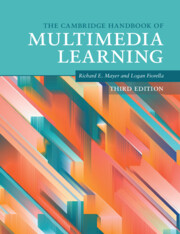Book contents
- The Cambridge Handbook of Multimedia Learning
- The Cambridge Handbook of Multimedia Learning
- Copyright page
- Contents
- Figures
- Tables
- Contributors
- Preface
- Acknowledgments
- Part I Background
- Part II Theoretical Foundations
- Part III Basic Principles of Multimedia Learning
- Part IV Principles for Reducing Extraneous Processing in Multimedia Learning
- Part V Principles for Managing Essential Processing in Multimedia Learning
- Part VI Principles Based on Social and Affective Features of Multimedia Learning
- Part VII Principles Based on Generative Activity in Multimedia Learning
- Part VIII Multimedia Learning with Media
- 37 Multimedia Learning with Cognitive Tutors
- 38 Multimedia Learning with Animated Pedagogical Agents
- 39 Multimedia Learning with Simulations
- 40 Multimedia Learning with Computer Games
- 41 Multimedia Learning with Instructional Video
- 42 Multimedia Learning in Virtual and Mixed Reality
- 43 Multimedia Learning with Visual Displays
- 44 Multimedia Learning from Multiple Documents
- 45 Multimedia Learning in e-Courses
- 46 Principles for Educational Assessment with Multimedia
- Author Index
- Subject Index
- References
45 - Multimedia Learning in e-Courses
from Part VIII - Multimedia Learning with Media
Published online by Cambridge University Press: 19 November 2021
- The Cambridge Handbook of Multimedia Learning
- The Cambridge Handbook of Multimedia Learning
- Copyright page
- Contents
- Figures
- Tables
- Contributors
- Preface
- Acknowledgments
- Part I Background
- Part II Theoretical Foundations
- Part III Basic Principles of Multimedia Learning
- Part IV Principles for Reducing Extraneous Processing in Multimedia Learning
- Part V Principles for Managing Essential Processing in Multimedia Learning
- Part VI Principles Based on Social and Affective Features of Multimedia Learning
- Part VII Principles Based on Generative Activity in Multimedia Learning
- Part VIII Multimedia Learning with Media
- 37 Multimedia Learning with Cognitive Tutors
- 38 Multimedia Learning with Animated Pedagogical Agents
- 39 Multimedia Learning with Simulations
- 40 Multimedia Learning with Computer Games
- 41 Multimedia Learning with Instructional Video
- 42 Multimedia Learning in Virtual and Mixed Reality
- 43 Multimedia Learning with Visual Displays
- 44 Multimedia Learning from Multiple Documents
- 45 Multimedia Learning in e-Courses
- 46 Principles for Educational Assessment with Multimedia
- Author Index
- Subject Index
- References
Summary
The sudden emergence of a lethal virus necessitating social distancing required billions of students worldwide to engage in various forms of e-learning, the effects of which are currently unknown. In some instructional contexts, the overall proportion of e-learning relative to in-person classes may continue on an upward trajectory. A long-history of media comparison research shows that learning is less a function of the delivery medium and more reflective of instructional methods that support human cognitive processes. In this chapter I emphasize evidence-based e-learning methods that (1) manage mental load, (2) promote productive engagement, and (3) offer feedback that guides learners to improved responses. I discuss the use of these methods to guide the design of digital explanations, engagement opportunities, and feedback in synchronous and asynchronous e-learning. I also discuss emerging digital learning opportunities in the form of interactive virtual reality and learning games.
- Type
- Chapter
- Information
- The Cambridge Handbook of Multimedia Learning , pp. 537 - 551Publisher: Cambridge University PressPrint publication year: 2021
References
- 1
- Cited by



